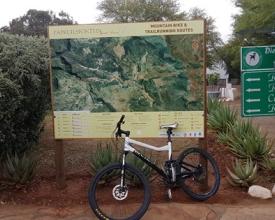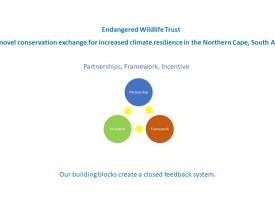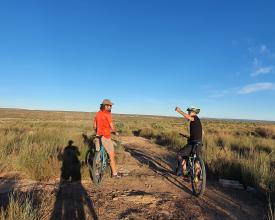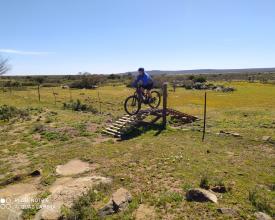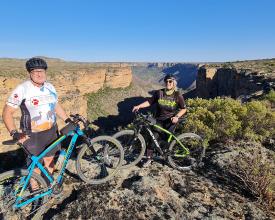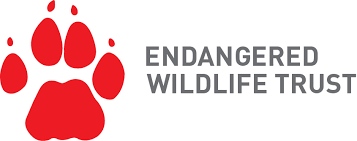
Un novedoso intercambio de conservación para aumentar la resistencia climática en el Cabo Septentrional (Sudáfrica)
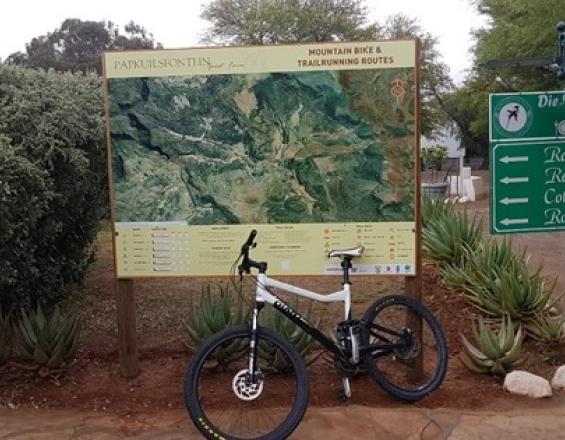
Nieuwoudtville es principalmente una zona de cría de ovejas y té, pero también la capital mundial del bulbo, con una industria turística estacional basada en el espectacular despliegue anual de flores silvestres. La mala gestión de los pastizales autóctonos y el cambio climático han hecho que la agricultura sea en gran medida inviable, obligando a los agricultores a diversificar sus fuentes de ingresos para seguir siendo económicamente viables.
A través de nuestro singular intercambio de conservación, aportamos conocimientos y recursos para construir senderos polivalentes en las granjas a cambio de que los propietarios firmen compromisos de adhesión al Programa de Gestión de la Biodiversidad (BSP, por sus siglas en inglés), un proceso voluntario pero legal para declarar las propiedades privadas como parte del patrimonio nacional de áreas protegidas.
Esta obligación se sustenta en planes de gestión que mejoran la gestión de los pastos e incluyen actividades como la carga ganadera correcta, el descanso del hábitat, el control de la erosión y la eliminación de plantas exóticas, todo lo cual mejora la capacidad de recuperación. De este modo demostramos que la conservación puede reportar beneficios tangibles a los agricultores.
Contexto
Défis à relever
El reto consiste en lograr múltiples resultados con una solución sencilla pero eficaz. Los retos en esta zona son: un clima cambiante que hace insostenibles las prácticas agrícolas tradicionales, la falta de oportunidades laborales y una temporada turística muy corta. Para que los agricultores adopten estrategias de diversificación de ingresos, necesitan tener acceso a un modelo probado, planes de gestión sólidos y apoyo para aplicar la solución. Hemos propuesto un modelo de intercambio conservación-turismo-agricultura, pero cualquier solución que se base en el medio ambiente requiere que el propio medio ambiente esté protegido. Para ello necesitamos estrategias que protejan la biodiversidad, el paisaje único y aumenten la resiliencia. Esta estrategia también habla de alargar la temporada turística y la duración de la estancia de los visitantes.
El escaso acceso a la educación superior limita la capacidad de los miembros de la comunidad para beneficiarse de las soluciones. Sin embargo, hemos posibilitado la participación a través de la creación de empresas derivadas, como guías, mochileros, mantenimiento de bicicletas, etc.
Ubicación
Procesar
Resumen del proceso
La asociación crea una base de confianza, entendimiento mutuo, claridad en las funciones y responsabilidades, y expectativas y resultados bien definidos. Esto es esencial, ya que da tranquilidad a las partes interesadas para comprometerse y seguir adelante con el Marco de Gestión de la Biodiversidad, en el que hay que firmar documentos legales y comprometerse con los planes de gestión y los planes operativos anuales. La voluntad de comprometerse con el marco significa que los beneficios para la conservación van a estar garantizados contractualmente y que el EWT puede activar el Incentivo, en este caso aportando financiación y experiencia para desarrollar senderos. Una vez operativos, los senderos producirán resultados financieros inmediatos para el agricultor y beneficios para el ecoturista. El incentivo demuestra a las partes que la asociación merece la pena, que funciona bien y que se han cumplido las promesas. Esto refuerza la asociación, lo que mejora la probabilidad de aplicación del marco y la sostenibilidad general del proyecto. También ayuda a generar el interés de otros agricultores que desean establecer operaciones similares, lo que conduce a una mayor ganancia de conservación orientada al paisaje.
Bloques de construcción
Asociaciones
Huelga decir que el cambio no puede producirse a menos que se base en asociaciones sólidas con funciones, responsabilidades y resultados claramente definidos. Cambiar las prácticas agrícolas es un reto, ya que estas prácticas arraigadas se han transmitido de generación en generación. El EWT puede ayudar al agricultor a salvar la distancia entre las técnicas agrícolas tradicionales y los conocimientos necesarios para la transición hacia modelos turísticos basados en la naturaleza.
Nos pareció esencial seleccionar a agricultores abiertos al cambio y ganarnos su confianza con productos probados y respeto mutuo. Para acelerar la puesta en marcha de los proyectos y evitar malentendidos, hay que definir claramente las funciones y responsabilidades. Nuestro proyecto fijó objetivos holísticos que apoyaban al agricultor y su familia, a los trabajadores de la granja, la conservación de la biodiversidad y proporcionaban una experiencia única a los entusiastas de las actividades al aire libre.
La creación de asociaciones duraderas y abiertas es una de las señas de identidad de este proyecto. Es parte de la base de nuestro éxito.
Factores facilitadores
- Confianza
- Canales de comunicación abiertos
- Claridad sobre lo que quieren las partes
- Voluntad de colaborar
- Proyectos realistas que estén bien pensados y puedan aportar de forma realista los beneficios esperados.
Lección aprendida
- La confianza y la colaboración se construyen con contactos regulares.
- La comunicación debe ser abierta y sincera.
- Si nos asegurábamos de que había un miembro del personal sobre el terreno, podíamos generar confianza más rápidamente. Contar con un miembro del personal de EWT en la zona para prestar servicios de extensión fue de vital importancia.
- Encontrar socios dispuestos y entusiastas es fundamental para el éxito.
- Ofrecer apoyo y ánimo constantes: si se promete hacer algo, hay que hacerlo.
- Asegurarse de que existe una situación recíproca en la que el agricultor también tiene responsabilidades que cumplir a su costa - esto conduce a unas relaciones más comprometidas en las que a todos interesa que el proyecto tenga éxito.
Marco de conservación
En Arica del Sur tenemos la suerte de contar con un programa legislativo muy progresista para la conservación en terrenos privados. El marco de Custodia de la Biodiversidad permite la declaración voluntaria de terrenos privados en la red de áreas protegidas siguiendo un proceso claramente definido. Como el proceso está bien establecido, es relativamente fácil aplicarlo y los compromisos se entienden bien. Sin embargo, las agencias de conservación gubernamentales tienen limitaciones en su capacidad y dependen de ONG, como el EWT, para facilitar el proceso de identificación de propiedades adecuadas, el compromiso con los agricultores y/o propietarios dispuestos y el desarrollo de las herramientas asociadas, como el plan de gestión de la finca y los planes anuales de funcionamiento.
Los propietarios firman un acuerdo con las autoridades provinciales de conservación por el que se formaliza la declaración en el título de propiedad. En gran medida, este marco resulta beneficioso para todos, ya que se conserva la biodiversidad, el país puede cumplir mejor sus objetivos de conservación en términos de acuerdos multilaterales y el agricultor dispone de una explotación agrícola más sostenible para su sustento. Las comunidades locales pueden obtener beneficios secundarios a través de oportunidades empresariales. Para proseguir nuestro intercambio de conservación, fusionamos este marco con otros acuerdos entre el agricultor y el EWT.
Factores facilitadores
- La ONG dispone de fondos y recursos sobre el terreno para comprometerse con los agricultores/propietarios.
- Que el propietario entienda exactamente a qué se compromete y las expectativas a largo plazo que debe cumplir. Esto debería basarse en términos contractuales claramente definidos.
- Voluntad del propietario de participar en el Programa de Gestión de la Biodiversidad.
- Voluntad de cambiar las prácticas agrícolas.
- Capacidad de ONG como Endangered Wildlife Trust para apoyar al agricultor a largo plazo.
- Buenas relaciones con los miembros locales del gobierno provincial.
Lección aprendida
- Un marco contractual es importante porque define claramente lo que se espera. Los contratos deben ser breves y concisos: hay que centrarse más en las funciones y responsabilidades que en la exigibilidad jurídica.
- La declaración de una propiedad en el marco del Programa de Gestión de la Biodiversidad puede llevar tiempo debido a los procesos de aprobación de los departamentos. Por lo tanto, es importante asegurarse de que los agricultores entienden los retrasos y en qué punto se encuentra el proceso.
- En lugar de centrarse en el proceso de gestión de la biodiversidad, hay que centrarse en la creación de un marco para mejorar la gestión y el apoyo necesario para conseguirlo.
Incentivos y sostenibilidad
Nuestro proyecto se basa en la premisa de que los agricultores quieren sostenibilidad y están incentivados para conseguirla. Ninguna explotación agrícola será viable a largo plazo si no se hace de forma ecológica y económicamente responsable. El cambio climático ha provocado un aumento de la frecuencia de las sequías y de su gravedad en las regiones occidentales de Sudáfrica. Los índices de carga ganadera están disminuyendo como consecuencia del cambio climático, lo que obliga a los ganaderos a diversificar sus ingresos para sobrevivir. La falta de cambio tendrá un impacto devastador en la biodiversidad.
Estamos incentivando a los agricultores para que protejan la biodiversidad mediante la adopción de prácticas agrícolas más sostenibles, como el descanso del pastoreo, tasas de carga ganadera correctas y actividades de restauración del hábitat. A pesar de ello, el ganadero sufre una pérdida de ingresos. Le ayudamos a compensar esta pérdida con actividades no agrícolas, como el ecoturismo.
Gracias a un compromiso continuo con el ganadero, podemos abordar las preocupaciones a medida que surgen y asegurarnos de que el ganadero percibe la participación activa en la asociación como un incentivo para mejorar su explotación.
Factores facilitadores
La región cuenta con una industria turística que puede aprovecharse. Conocida como la "capital mundial del bulbo", la zona es muy conocida y está relativamente cerca (a 3,5 horas en coche) de un aeropuerto internacional. Sin embargo, esta temporada dura aproximadamente 2 meses, y este proyecto pretende ampliar las operaciones turísticas a todo el año.
El agricultor debe estar abierto al turismo como medio de generar ingresos turísticos.
El proyecto tiene potencial inmediato para generar ingresos adicionales y puede diseñarse a medida para adaptarse a la infraestructura y las capacidades del agricultor.
Lección aprendida
- Elija proyectos rápidos de poner en marcha y de mostrar resultados, lo que impulsará las asociaciones y mejorará las posibilidades de que se cumplan otras promesas.
- A los agricultores no les gusta el papeleo ni la administración y a menudo necesitan apoyo en este ámbito, sobre todo en lo que se refiere a la nueva empresa.
- Es muy importante demostrar que el incentivo funciona, ya que así se sustenta la continuidad de la colaboración. Celebre los pequeños éxitos.
Impactos
Medio ambiente: El proyecto se puso a prueba en la finca Papkuilsfontein, una magnífica explotación de 7.000 ha cuyo estado de conservación está en proceso de ser elevado a la categoría de Medio Ambiente Protegido; la segunda categoría más alta dentro de la jerarquía de áreas protegidas de Sudáfrica. Se ha completado un plan de gestión que aborda las prácticas de gestión de la finca. En última instancia, esto redundará en una mejor gestión de la conservación de la granja, una menor degradación del hábitat y una mayor resistencia al cambio climático.
Social: Los senderos construidos hasta la fecha han atraído a más visitantes a la granja para que conozcan su increíble biodiversidad. Actualmente estamos formando a dos guías locales, que se graduarán a finales de 2021 para dirigir las visitas y mejorar la experiencia de los visitantes.
Económico: Un mayor número de visitantes que acuden a la granja para utilizar los senderos significa que el impacto económico no sólo es mayor, sino que además se reparte a lo largo de todo el año. Esto supone una mayor seguridad laboral para los trabajadores que antes sólo trabajaban durante la limitada temporada turística de las flores. El aumento del turismo también tiene un efecto multiplicador en la economía de la ciudad en general, lo que es importante en esta zona bastante remota que experimenta altas tasas de desempleo y ofrece pocas oportunidades de trabajo. El agricultor puede variar sus prácticas agrícolas, ya que sus ingresos globales están más diversificados y son menos propensos a los riesgos climáticos asociados a la cría exclusiva de ovejas.
Beneficiarios
Los agricultores y trabajadores agrícolas de Papkuilsfontein, los miembros de la comunidad de Nieuwoudtville formados como guías, la comunidad de Nieuwoudtville con respecto al efecto multiplicador económico del aumento del turismo. Turistas que pueden acceder a nuevas experiencias en la naturaleza.
Objetivos de Desarrollo Sostenible
Historia
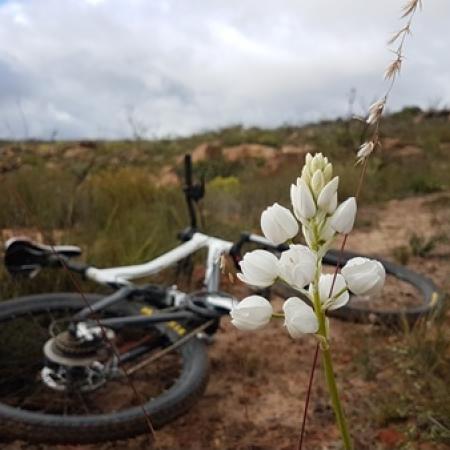
En 2017, el EWT inició una labor de gestión sostenible de la tierra en el marco del proyecto financiado por el FMAM 5 "Garantizar múltiples beneficios ecosistémicos mediante la gestión sostenible de la tierra (GST) en los paisajes productivos pero degradados de Sudáfrica" (el nodo del Karoo, árido interior occidental de Sudáfrica).
Desde el principio nos apartamos de los planteamientos tradicionales, según los cuales los emplazamientos de los proyectos se seleccionaban en función de la degradación de la tierra, y en su lugar utilizamos la "voluntad de colaborar" como factor decisivo para seleccionar a los socios. Con este planteamiento, identificamos a la familia Van Wyk en Nieuwoudtville y su granja de 7.000 hectáreas llamada Papkuilsfontein, como un lugar adecuado para poner a prueba nuestro innovador trabajo.
Su apertura y su deseo de sostenibilidad fueron evidentes de inmediato. Desarrollamos una asociación significativa y firmamos acuerdos para consolidar el proyecto. Discutimos varias ideas para un proyecto de GST, incluida la de una red de senderos para diversificar los ingresos, que atrajo inmediatamente a la familia Van Wyk.
Con fondos adicionales del PNUD y del Rand Merchant Bank, nuestro colaborador en la zona, JP le Roux, empezó a construir senderos a principios de 2020. Desgraciadamente, la pandemia de COVID-19 provocó algunos retrasos, pero, a pesar de ello, se han completado más de 100 km de senderos y están plenamente operativos.
Incluso antes de que los senderos de Papkuilsfontein estuvieran terminados, vimos cómo los utilizaban los visitantes: corredores y ciclistas de montaña. A pesar de las restricciones de viaje debidas a la pandemia, el primer año de funcionamiento ya ha generado beneficios económicos para la granja y la comunidad. Ha tenido tanto éxito que los terratenientes adyacentes se han puesto en contacto con el EWT para participar en este programa de intercambio de conservación. El impacto hasta la fecha ha sido asombroso, e incluso bajo las restricciones ecoturísticas más desafiantes a consecuencia del covid, los senderos han ilustrado su potencial de sostenibilidad.
Seleccionar al socio adecuado para la gestión de la tierra es fundamental. En la familia van Wyk encontramos personas dispuestas a comprometer sus propios recursos y determinación no sólo para que el componente de los senderos funcione, sino también para poner en marcha las acciones necesarias para una mejor protección de la biodiversidad de su finca.
Estos campeones de la conservación nos han ayudado a promover ideas y acciones entre otros agricultores de su comunidad, demostrando que las acciones de conservación están en última instancia en manos de los propietarios de las tierras y que éstas pueden reportar beneficios a todas las partes interesadas. Ése es el poder de este concepto.
